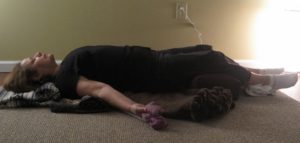OM Shanti, Shanti, Shanti
Putting on the oxygen mask first to yourself. I shared with you in class this week, my own chanting to the peace within, sending peace to others and to the universe. See some of the other yogic words that you might hear in your classes.
5 Sanskrit Words Every Yogi Should Know
No, your teacher isn’t speaking gibberish. He or she is probably speaking Sanskrit– an ancient language from southern India. Here are the 5 words you’ll hear most frequently in your classes.
1. Asana.
My first yoga teacher put the accent on the second syllable, like this: ah-SAW’-nah. I still think that has a nice ring to it. But the correct pronunciation is AH’-sah-nah. Literally, it means “seat,” but in yoga class it’s pretty much interchangeable with the word “pose.” For example, Balasana = Child’s Pose, Navasana = Boat Pose… and so on.
2. Namaste.
This is my favorite Sanskrit word because it’s fun to say–nah’-mah’-stay. It means: The divine light within me salutes the divine light within you. My incredibly simplified translation: I’m awesome. You’re awesome. All these other people are awesome. Isn’t it awesome that we just practiced yoga together? Thanks for your presence.
3. Om.
Ooooooohhhhhmmmmmmm. Apparently, this is the sound of the universe. The written version of Om has become a universal symbol of yoga–it adorns yoga studio walls and is tattooed on yoga students everywhere. But what does it mean? Essentially, we are all a part of this universe–always moving, always changing, always breathing. When you chant Om, you’re tapping into that vibration.
4. Shanti.
Peace. When you chant, “Om shanti shanti shanti,” it’s an invocation of peace. In Buddhist and Hindu traditions you chant shanti three times to represent peace in body, speech, and mind.
5. Yoga.
We all know that yoga is the union of body, mind, and spirit. That’s what the word yoga means–yoke or union. It is, indeed, the practice of connecting our body, mind, and spirit, but it can mean more than that, too. It’s about connecting us to ourselves, each other, our environment, and, eventually, our truth.
Erica Rodefer is a writer and yoga practitioner living in Charleston, SC. Visit her blog, Spoiledyogi.com, follow her on Twitter, or like her on Facebook.
Poses
Half Legs Up
Props: 2 blocks, bolster, 2 blankets, eye and neck pillow
Benefits: increases circulation and helps venous and lymphatic flow from the lower body; relieves swelling and fatigue in the legs; helps relieve muscular skeletal stress in pelvis; quiets the mind and can help promote ease in meditation and sleep.
Use the 2 blocks, setting one at a lower height than the other, place bolster lengthwise on the blocks inclined. One leg will rest on the floor with a blanket covering and one leg will rest on the inclined bolster with blanket covering. Arms can stay at your side, move to Goddess (shown) or hands can rest at belly. cover yourself for more warmth and add an eye pillow to shut out the light for deeper relaxation.



Leave A Comment